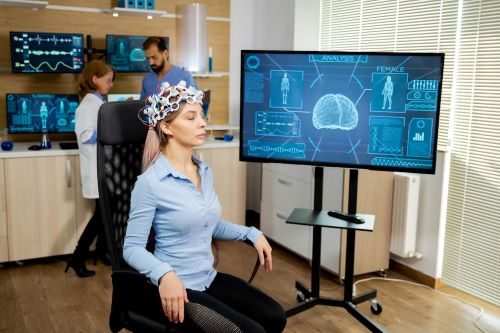The Physiological Monitors Global Market Report 2024 by The Business Research Company provides market overview across 60+ geographies in the seven regions – Asia-Pacific, Western Europe, Eastern Europe, North America, South America, the Middle East, and Africa, encompassing 27 major global industries. The report presents a comprehensive analysis over a ten-year historic period (2010-2021) and extends its insights into a ten-year forecast period (2023-2033).
Learn More On The Physiological Monitors Market:
https://www.thebusinessresearchcompany.com/report/physiological-monitors-global-market-report
According to The Business Research Company’s Physiological Monitors Global Market Report 2024, The physiological monitors market size has grown rapidly in recent years. It will grow from $92.32 billion in 2023 to $103.11 billion in 2024 at a compound annual growth rate (CAGR) of 11.7%. The growth in the historic period can be attributed to aging population, chronic disease management, patient-centric healthcare, integration with electronic health records (ehr), iot and connectivity.
The physiological monitors market size is expected to see rapid growth in the next few years. It will grow to $158.62 billion in 2028 at a compound annual growth rate (CAGR) of 11.4%. The growth in the forecast period can be attributed to ai and data analytics integration, focus on preventive healthcare, telehealth expansion, home healthcare trends, global health challenges. Major trends in the forecast period include wearable technology adoption, technological miniaturization, remote patient monitoring. advancements in healthcare technology, non-invasive monitoring technologies.
The rising prevalence of chronic diseases is expected to propel the growth of the physiological monitors market going forward. A chronic disease is a health issue or condition with long-lasting symptoms lasting for at least a year. Physiological monitors aid in managing the prevalence of chronic diseases by providing real-time health data, enabling timely interventions and personalized care for individuals with chronic conditions. For instance, in January 2023, according to the National Institutes of Health (NIH), a US-based government agency, the prevalence of chronic diseases among the U.S. population aged 50 years and older is projected to increase by 99.5%, reaching 142.66 million individuals by 2050, reflecting a significant increase from the 71.522 million reported in 2020. Therefore, the rising prevalence of chronic diseases drives the growth of the physiological monitors market.
Get A Free Sample Of The Report (Includes Graphs And Tables):
https://www.thebusinessresearchcompany.com/sample.aspx?id=13722&type=smp
The physiological monitors market covered in this report is segmented –
1) By Type: Hemodynamic Monitoring Devices, Neuromonitoring Devices, Cardiac Monitoring Devices, Respiratory Monitoring Devices, Other Types
2) By Application: Cardiology, Neurology, Respiratory, Fetal And Neonatal, Weight Management And Fitness Monitoring, Other Applications
3) By End User: Hospital, Clinic, Other End Users
Major companies operating in the physiological monitors market are increasing their focus on developing advanced solutions, such as wireless patient monitoring systems, to gain a competitive edge in the market. A wireless patient monitoring system is a technological advancement that eliminates the need for wires or cables to continuously monitor a patient’s vital signs, including blood pressure, heart rate, oxygen levels, and more. For instance, in June 2022, GE Healthcare Technologies Inc., a US-based medical technology company, launched Portrait Mobile. This system is designed to help clinicians detect patient deterioration earlier and improve patient outcomes. Portrait Mobile uses wearable sensors placed on the patient’s body to collect data on their vital signs, such as heart rate, blood pressure, oxygen levels, and respiration rate. It provides continuous monitoring of a patient’s vital signs, which can help clinicians detect changes in a patient’s condition more quickly.
The physiological monitors market report table of contents includes:
1. Executive Summary
2. Physiological Monitors Market Characteristics
3. Physiological Monitors Market Trends And Strategies
4. Physiological Monitors Market – Macro Economic Scenario
5. Global Physiological Monitors Market Size and Growth
……
32. Global Physiological Monitors Market Competitive Benchmarking
33. Global Physiological Monitors Market Competitive Dashboard
34. Key Mergers And Acquisitions In The Physiological Monitors Market
35. Physiological Monitors Market Future Outlook and Potential Analysis
36. Appendix
Related Reports:
https://topprnews.com/instrument-cluster-market-forecast/
https://topprnews.com/intermittent-pneumatic-compression-ipc-devices-market-report/
https://topprnews.com/interstitial-cystitis-drugs-system-market-report/
https://goodprnews.com/webbing-market-trends/
https://goodprnews.com/webcam-market-forecast/
https://goodprnews.com/weight-loss-supplements-market-growth/
Contact Us:
The Business Research Company
Europe: +44 207 1930 708
Asia: +91 88972 63534
Americas: +1 315 623 0293
Email: [email protected]
Follow Us On:
LinkedIn: https://in.linkedin.com/company/the-business-research-company
Twitter: https://twitter.com/tbrc_info
Facebook: https://www.facebook.com/TheBusinessResearchCompany
YouTube: https://www.youtube.com/channel/UC24_fI0rV8cR5DxlCpgmyFQ
Blog: https://blog.tbrc.info/
Healthcare Blog: https://healthcareresearchreports.com/
Global Market Model: https://www.thebusinessresearchcompany.com/global-market-model




